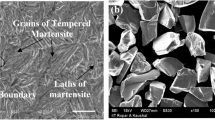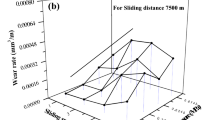Abstract
The present research article describes a study on the wear resistance of high manganese Hadfield steel produced through a clean metallurgical process during dry sliding wear conditions; solidified ingots are subjected to heat treatments, such as annealing, ice water quenching, and age hardening for 2 h at 550 °C, 600 °C, 650 °C, and 700 °C. Samples are prepared as per the standards for mechanical and tribological tests. The peak hardness of 292.87 HV is observed for alloy 4 aged at 600 °C. The ultimate tensile strength of 434.18 MPa is observed for alloy 3 aged at 600 °C. The minimum specific wear rate of 1.5649E-05 mm3/N-m is witnessed for the as-cast sample of alloy 4 at 50 N load and 1.885 m/s speed. Wear tracks are analyzed through SEM, and microstructures are retrieved from OM, SEM, and TEM. The XRD patterns revealed the developed steel is austenitic in nature. Furthermore, to validate the wear rate, a total of 8 machine learning models/ensembles are developed and trained as it is obvious to associate tribological and material features with ML models. With an efficiency of 94%, Decision Tree Regressor outperformed all other constructed models using R2 values as the performance assessment criterion.













Similar content being viewed by others
Availability of Data and Materials
Not applicable.
References
L. Tan, D. Li, L. Yan, X. Pang, K. Gao, Simultaneous enhancement of strength-ductility via multiple precipitates and austenite in a novel precipitation-hardened martensitic stainless steel. Mater. Sci. Eng. A 873, 145062 (2023)
W. Hagedorn, A. Gramlich, K. Greiff, U. Krupp, Alloy and process design of forging steels for better environmental performance. Sustain. Mater. Technol. 34, e00509 (2022). https://doi.org/10.1016/j.susmat.2022.e00509
A.M. Abd El-Hameed, Y.A. Abdel-Aziz, Aluminium alloys in space applications: a short report. J. Adv. Res. Appl. Sci. Eng. Technol. 22(1), 1–7 (2021). https://doi.org/10.37934/araset.22.1.17
A.A. Mohamed, M.K. El-fawkhry, W.M. El-nahas, The effect of precipitation hardening on the properties hadfield steel. ERJ. Eng. Res. J. 43(2), 119–125 (2020). https://doi.org/10.21608/erjm.2020.83899
M.K. Banerjee, Heat Treatment of Commercial Steels for Engineering Applications, vol. 2–3. Elsevier Ltd., (2017)
B.P. Harsha, A. Patnaik, M.K. Banerjee, E. Kozeschnik, Hardening behaviour, mechanical properties and wear evaluation of TRIP/TWIP manganese steels: a comprehensive review. Mater. Today Proc. (2023). https://doi.org/10.1016/j.matpr.2023.04.012
K. Wang et al., Effect of microstructure transformation below MS temperature in bainitic steels on the impact-abrasive wear behavior. Wear 514–515, 204589 (2023). https://doi.org/10.1016/j.wear.2022.204589
Z. Cai, S. Wang, Y. Zhou, J. Dong, C. Yu, L. Ma, The synergistic effect of grain refinement and precipitation strengthening on mechanical properties and dry sliding wear behavior of medium manganese steels. Tribol. Int. 179, 108158 (2023). https://doi.org/10.1016/j.triboint.2022.108158
B.P. Harsha, A. Patnaik, M.K. Banerjee, E. Kozeschnik, Physical, mechanical, and tribological assessment of high manganese-silicon steel alloys. SILICON (2022). https://doi.org/10.1007/s12633-022-02260-y
S.P. Neog, S. Das Bakshi, S. Das, Effect of normal loading on microstructural evolution and sliding wear behaviour of novel continuously cooled carbide free bainitic steel. Tribol. Int. 157, 106846 (2021). https://doi.org/10.1016/j.triboint.2020.106846
M.K. Chowrasia, A. Kumar, M.K. Banerjee, U. Pandel, Effect of aging on structure and properties of a transformation-induced plasticity-aided. J. Mater. Eng. Perform. (2019). https://doi.org/10.1007/s11665-020-04575-6
M. Sabzi, M. Farzam, Hadfield manganese austenitic steel: a review of manufacturing processes and properties. Mater. Res. Express 6, 10 (2019). https://doi.org/10.1088/2053-1591/ab3ee3
X. Yan, J. Hu, X. Zhang, W. Xu, Obtaining superior low-temperature wear resistance in Q&P-processed medium Mn steel with a low initial hardness. Tribol. Int. 175, 107803 (2022). https://doi.org/10.1016/j.triboint.2022.107803
N. Yin, Z. Xing, K. He, Z. Zhang, Tribo-informatics approaches in tribology research: a review. Friction 11(1), 1–22 (2022). https://doi.org/10.1007/s40544-022-0596-7
Z. Zhang, N. Yin, S. Chen, C. Liu, Tribo-informatics: concept, architecture, and case study. Friction 9, 642–655 (2021)
I. Argatov, Artificial neural networks (ANNs) as a novel modeling technique in tribology. Front. Mech. Eng. 5(May), 1–9 (2019). https://doi.org/10.3389/fmech.2019.00030
A. Rosenkranz, M. Marian, F.J. Profito, N. Aragon, R. Shah, The use of artificial intelligence in tribology—a perspective. Lubricants 9(1), 1–11 (2021). https://doi.org/10.3390/lubricants9010002
P. Kügler, M. Marian, B. Schleich, S. Tremmel, S. Wartzack, tribAIn-towards an explicit specification of shared tribological understanding. Appl. Sci. (2020). https://doi.org/10.3390/app10134421
S. Ayadi, A. Hadji, K. Hakan, S. Demirtaş, Microstructure and wear behavior of a Cr–Mo–Nb alloyed manganese steel. J. Mater. Res. Technol. 9(5), 11545–11562 (2020). https://doi.org/10.1016/j.jmrt.2020.08.048
D. Fernández-Valdés, A. Meneses-Amador, A. López-Liévano, A. Ocampo-Ramírez, Sliding wear analysis in borided AISI 316L steels. Mater. Lett. (2021). https://doi.org/10.1016/j.matlet.2020.129138
L. Huang, X. Deng, Q. Wang, Y. Jia, C. Li, Z. Wang, Solidification and sliding wear behavior of low-alloy abrasion-resistant steel reinforced with TiC particles. Wear 458–459, 203444 (2020). https://doi.org/10.1016/j.wear.2020.203444
P.V. Moghaddam, J. Hardell, E. Vuorinen, B. Prakash, Effect of retained austenite on adhesion-dominated wear of nanostructured carbide-free bainitic steel. Tribol. Int. 150, 106348 (2020). https://doi.org/10.1016/j.triboint.2020.106348
C. Zhang, A. Kotz, K. Kelly, L. Rippelmeyer, Development of heavy-duty vehicle representative driving cycles via decision tree regression. Transp. Res. Part D Transp. Environ. 95, 102843 (2021). https://doi.org/10.1016/j.trd.2021.102843
M.S. Hasan, A. Kordijazi, P.K. Rohatgi, M. Nosonovsky, Triboinformatic modeling of dry friction and wear of aluminum base alloys using machine learning algorithms. Tribol. Int. 161, 107065 (2021). https://doi.org/10.1016/j.triboint.2021.107065
H. Wang, C. Zhang, X. Yu, Y. Li, Evaluating wear volume of oligoether esters with an interpretable machine learning approach. Tribol. Lett. (2023). https://doi.org/10.1007/s11249-023-01715-6
K. Pandiaraj, P. Sivakumar, K.J. Prakash, Machine learning based effective linear regression model for TSV layer assignment in 3DIC. Microprocess. Microsyst. 83, 103953 (2021). https://doi.org/10.1016/j.micpro.2021.103953
L. Xiong, Y. Yao, Study on an adaptive thermal comfort model with K-nearest-neighbors (KNN) algorithm. Build. Environ. 202, 108026 (2021). https://doi.org/10.1016/j.buildenv.2021.108026
M.W. Ahmad, J. Reynolds, Y. Rezgui, Predictive modelling for solar thermal energy systems: a comparison of support vector regression, random forest, extra trees and regression trees. J. Clean. Prod. 203, 810–821 (2018). https://doi.org/10.1016/j.jclepro.2018.08.207
A. Ahmad, K.A. Ostrowski, M. Maślak, F. Farooq, I. Mehmood, A. Nafees, Comparative study of supervised machine learning algorithms for predicting the compressive strength of concrete at high temperature. Materials (2021). https://doi.org/10.3390/ma14154222
H.D. Nguyen, G.T. Truong, M. Shin, Development of extreme gradient boosting model for prediction of punching shear resistance of r/c interior slabs. Eng. Struct. 235, 112067 (2021). https://doi.org/10.1016/j.engstruct.2021.112067
M.C. Kang, D.Y. Yoo, R. Gupta, Machine learning-based prediction for compressive and flexural strengths of steel fiber-reinforced concrete. Constr. Build. Mater. 266, 121117 (2021). https://doi.org/10.1016/j.conbuildmat.2020.121117
J.H. Zhou, Y.F. Shen, Y.Y. Hong, W.Y. Xue, R.D.K. Misra, Materials science and engineering a strengthening a fine-grained low activation martensitic steel by nanosized carbides. Mater. Sci. Eng. A 769, 138471 (2020). https://doi.org/10.1016/j.msea.2019.138471
R. Zellagui et al., Effect of heat treatments on the microstructure, mechanical, wear and corrosion resistance of casted hadfield steel. Int. J. Met. 16(4), 2050–2064 (2022). https://doi.org/10.1007/s40962-021-00751-z
H. Si, R. Xiong, F. Song, Y. Wen, H. Peng, Wear resistance of austenitic steel Fe–17Mn–6Si–0.3 C with high silicon and high manganese. Acta Metall. Sin. 27, 352–358 (2014). https://doi.org/10.1007/s40195-014-0054-2
M.K. El Fawkhry, Modified hadfield steel for castings of high and low gouging applications. Int. J. Met. (2020). https://doi.org/10.1007/s40962-020-00492-5
Acknowledgements
The authors would like to express their heartfelt gratitude towards the Scheme for Promotion of Academic and Research Collaboration (SPARC), Ministry of Education, Government of India, for funding the project. The authors would also like to acknowledge the Advanced research lab for Tribology (ARLT) and Materials Research Centre (MRC), Malaviya National Institute of Technology Jaipur, India, for providing the necessary fabrication and testing facilities.
Funding
This work is supported by the Scheme for Promotion of Academic and Research Collaboration (SPARC), Ministry of Education, Government of India (Grant number: SPARC/2018-2019/P828/SL).
Author information
Authors and Affiliations
Contributions
All the authors have contributed to the study conception and design. Material preparation, data collection, and analysis are performed by HBP, AP, MKB, and EK. HBP contributed to Conceptualization, methodology, investigation, and writing—original draft preparation. AP: Resources, writing—reviewing, editing, validation, and supervision. MKB contributed to Revised the manuscript critically for important intellectual content along with editing, validating, and supervision. EK contributed to Formal analysis, visualization, and supervision. The first draft of the manuscript was written by HBP, and all the authors have read and approved the final manuscript.
Corresponding author
Ethics declarations
Conflict of interest
The authors have no relevant financial or non-financial interests to disclose.
Ethics Approval
We confirm that this manuscript has not been published elsewhere and is not under consideration by another journal. All the authors have approved the manuscript and agree with its submission to 'International Journal of Metal Casting' journal.
Consent to Participate
Not applicable.
Consent to Publish
Not applicable.
Additional information
Publisher's Note
Springer Nature remains neutral with regard to jurisdictional claims in published maps and institutional affiliations.
Supplementary Information
Below is the link to the electronic supplementary material.
Rights and permissions
Springer Nature or its licensor (e.g. a society or other partner) holds exclusive rights to this article under a publishing agreement with the author(s) or other rightsholder(s); author self-archiving of the accepted manuscript version of this article is solely governed by the terms of such publishing agreement and applicable law.
About this article
Cite this article
Harsha, B.P., Patnaik, A., Banerjee, M.K. et al. Triboinformatics Modeling of Dry Sliding Wear of High Manganese Hadfield Steel alloys. Inter Metalcast 18, 1750–1769 (2024). https://doi.org/10.1007/s40962-023-01147-x
Received:
Accepted:
Published:
Issue Date:
DOI: https://doi.org/10.1007/s40962-023-01147-x




